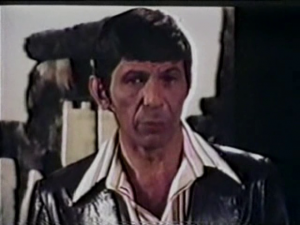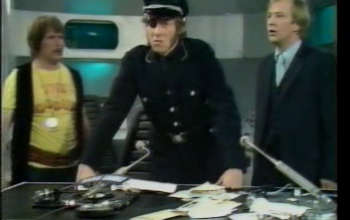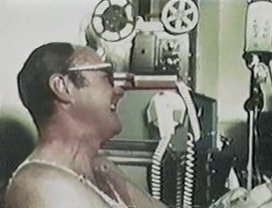In Search Of… S01E23 Inca Treasures
We begin with lovely footage of the Andes — which as you know are covered by the Gloveys. Sorry, that was awful. Coffee hasn’t kicked in yet. Anyway, Nimoy tells us that ‘it is believed’ that there is treasure there, the lost treasure of the Incas. He tells us that ‘white men’ called the Incan Empire ‘El Dorado’ which is… Look, it’s just wrong, okay?

We intercut pictures of the mountains and golden Incan artifacts. There’s a beautiful, if slightly confusing, prose-poem about searching for treasure, and then we see some Peruvian guys hacking their way through the forest. We’re told that the In Search Of… cameras have come closer than anyone to the ‘heart of the mystery of the great Inca treasure.’
Parse that, if you dare
Now more footage of mountains and Nimoy’s telling us that the area has attracted the greedy and the curious for ages. There’s some footage of people doing actual Inca archaeology, but Nimoy tells us that for ‘some people, pottery shards and broken masonry is not enough. They seek the precious yellow metal called… gold.’
Try to imagine someone other than Leonard Nimoy saying that last line, and still being taken seriously. Go on, try. I’ll keep going while you do that.
Back in the studio, Nimoy — in a leather jacket and the biggest wing-collar you ever saw — waxes lyrical about the exotic nature of Peru. Nearly three minutes in, and basically nothing of substance. Got a feeling this one’s going to be a little slender.
Back to Peru, we look at Cuzco, a still living Inca city. Nimoy talks a bit about the locals and their imperial Inca ancestors, and we see footage of Inca art and architecture. I’m wondering if this episode is a bit of a bait-and-switch, with talk of lost treasure a way to bring in the punters to a straightforward archaeological documentary. We’ll see.
We see Inca fortresses, irrigation systems, and mummies. We see some Peruvian academics examine the last of these while Nimoy meanders between relevant information and poetry. He describes grave archaeology as an ‘irreverence born of a need to know’ which is a nice way of putting it, and the close ups of the mummy is super cool. Nimoy talks about gold and grave robbers, before going back to reading the World Book entry on ‘Inca’.
Now we’re talking about how the rich and powerful of the Incan Empire ‘vanished into the jungle’ after the Spanish conquest. Now we’re talking about Hyram Bingham, the archaeologist who rediscovered Macchu Piccu.Well, actually, I gather his priority is disputed. Even so, I’m giving the show a pass on this one, because it’s not a major issue in the documentary.
It’s not a bad retelling of Bingham’s story, but it’s all put into this silly ‘hunt for gold’ framework. I’m pretty sure neither Bingham nor any other archaeologist, would think it necessary for there to be gold in a lost city to make finding a lost city awesome. Certainly, the narration makes frequent use of the phrase ‘would have’, which is a code for ‘we found no evidence of this at all, but let’s speculate.’
There’s some charmingly silly footage intermixing handheld camera footage of Macchu Picchu with quick cuts to Inca gold artifacts. We’re told Bingham was considered a hero of his time, but he was wrong to believe that it was the legendary ‘final capital’ of the Inca rulers. Still, the footage is lovely.
In Lima, We see Professor Edmundo Guillén, an expert in Incan studies. We’re told that he made a remarkable discovery, and that the In Search Of… cameras were there to see it.
Hm. Round about this time, I should be heading to Wikipedia to look up Professor Guillén. This time, though, I think I’ll wait.
North of Cuzco, we see Prof Guillén and colleagues on mules, heading into the Andes. It’s pretty cool. It looks like a western, almost. Prof Guillén’s theory was that Pizarro represented “the beginning of the end” of the Inca Empire, rather than the actual end. Nimoy compared Guillén to Bingham. “Bingham didn’t have the blood of Incans in his veins. Guillén does,” Nimoy tells us. Not sure that’s how archaeology works, but whatever.
More padding, but this time its shots of the professor looking out over the Andes, so I’m not complaining. Guillén found letters from Spanish soldiers which he believes gives directions to the final Inca capital, Vilacamba. On the way up this beautiful river, all these archaeologists in big hats find a crypt. How awesome is that?
You see, In Search Of…? Real archaeology can be cool too. No need for aliens/Atlanteans/trans-Atlantic Phoenicians every time. What’s more… Oh, no time for me to lecture, they’re hacking through the forest with machetes. Sweet! And here they are at the lost city. Vilcabamba, four hundred and three years after it was sacked by the Spanish.
Nimoy talks about the glory of the Inca and the long retreat from the Spanish. It’s basically padding, since we’ve heard it all before. But it’s nice to hear this show talk about the glories of an ancient society without trying to palm off the credit for building it onto someone else.
And now we’re watching actual archaeologists doing actual archaeology. No sign of gold, we’re talking about roofing tiles and how they help us date Inca ruins. We see people surveying, digging, sketching. Guillén clears some crap out of a water pipe, and it starts flowing. After four hundred years, the plumbing still works. Now that is impressive.
We’re shown temples (which, we’re assured, used to be full of gold), and get a nice little soliloquy on Incan astronomy. Guillén believes that the Incas struggled against the Spaniards for forty years, rather than collapsing almost immediately popular belief has it. The expedition raises the Peruvian flag and sings what I guess is their national anthem. “It’s good to be home,” says Nimoy, and I honestly don’t know if that’s cool or patronising.
Back in the studio, Nimoy points out what we already guessed – there was no gold found in Vilcabamba. Not really an issue, of course — unless we were watching a documentary account that chooses to make it an issue… D’oh! Oh well. Guillén discovered the “treasure of satisfaction and achievement.” No doubt university authorities gave him a sticker for encouragement.
So is this episode bullshit? Well, only a little. The whole “there’s gold in them thar’ mountains” through-line was unhelpful and unnecessary, but we’ve seen how nonsensical this show can get about archaeology so I don’t think I should complain too much about this low level sensationalism. No, the big issue (and I’ve done some reading on this now) is that the lost city wasn’t discovered right before the In Search Of cameras. The site had been known since the 1960s, though Professor Guillén did some important surveying work in 1976, and his researches in Spanish archives did help confirm that the place is indeed Vilcabamba.
Again, as far as this show goes, it’s not too bad. If you watch this episode, you will learn more true things than false things. Whether that’s a plus or a minus is up to you.
Best lines
Nimoy: “If the mountains could speak, they’d tell a sad story—a story of lust, and greed, and treachery.”
Nimoy: “Great effort is still required, if the last chapter to the Incan Empire is not to be written from the memoirs of some long-dead Spanish priest who may have been angered because proud savages worshiped the sun.” — Yikes!
Prof Guillén: “Viva Vilcabamba. Viva Peru.”
Summing up
Actual, Bona Fide Documentary: 10/10, Nimoyness: 10/10, Intrusive Electronic Music: 9/10, Beautiful Andean Travelogue: 10/10, “Incan Treasure” 0/10. Overall: 39/50. Distinction.



